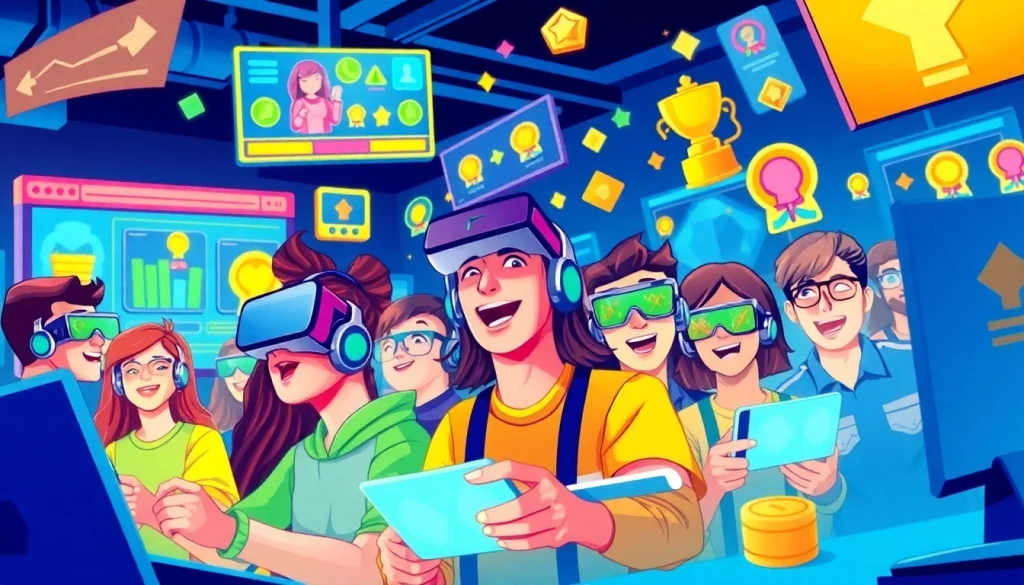
Understanding Customer Gamification in the Gaming Sector
Definition and Importance of Customer Gamification
Customer gamification in the gaming sector refers to the integration of game-like elements into non-game contexts to enhance player engagement, loyalty, and interaction. This approach utilizes various techniques such as point scoring, leaderboards, achievements, and challenges to motivate players to achieve their goals and interact more actively with the platform. As the gaming market continues to evolve, the importance of gamification cannot be overstated; it not only improves user experience but also drives retention rates and fosters community building among players. By implementing customer gamification strategies, gaming companies can create immersive experiences that resonate with their audiences.
How Customer Gamification Drives Player Engagement
The core objective of customer gamification is to boost player engagement. Gamification taps into intrinsic motivators—such as competition, achievement, and social interaction—making gaming experiences more enjoyable and rewarding. By integrating challenges and rewards, gaming platforms can encourage players to log in more frequently, participate in events, and spend more time within the ecosystem. Furthermore, by fostering a sense of community through cooperative and competitive elements, gamification helps players build relationships, thereby increasing their emotional investment in the game. Procedural challenges, narrative elements, and themed quests keep engagement high, ensuring players remain interested and active over time.
Key Trends in Customer Gamification for 2025
As we move further into 2025, several key trends are becoming evident in customer gamification within the gaming industry:
- Personalization: Tailored experiences based on player behavior, preferences, and demographics are on the rise, enhancing the relevance of gamified elements.
- Mobile Integration: With the continued growth of mobile gaming, gamification designs are being optimized for mobile devices, allowing players to engage anytime, anywhere.
- Social Sharing: Many platforms are incorporating social media features, enabling players to share achievements and progress, which boosts social interaction and community building.
- AR and VR Experiences: The integration of augmented and virtual reality is providing unique gamified experiences that physically immerse players in the gaming environment.
- Data-Driven Insights: Using analytics to understand player behavior and preferences is guiding the development of more engaging and effective gamification strategies.
Common Challenges in Implementing Customer Gamification
Identifying Effective Game Mechanics
Integrating the right game mechanics can be a significant challenge. Not all players respond positively to the same gamification elements, and what works for one demographic may not resonate with another. To overcome this, developers should conduct thorough research, involving player feedback and A/B testing to uncover which mechanics—be it leaderboards, points, badges, or challenges—are most effective in inspiring engagement.
Avoiding Over-Gamification Pitfalls
While gamification can enhance engagement, over-gamification can lead to player frustration and disengagement. Bombarding players with too many rewards or overly complex systems can overwhelm them, causing irritation rather than motivation. Striking a balance is essential—implement gamified elements that align with the core objectives of the game, and ensure they enhance, rather than complicate, the user experience.
Measuring Engagement Success Metrics
To truly understand the effectiveness of gamification strategies, it is essential to define and measure key performance indicators (KPIs). Metrics such as Daily Active Users (DAU), retention rates, session length, and player progression can provide insights into how well gamification is performing. Additionally, qualitative feedback through player surveys can offer context to the data, helping refine gamification practices.
Best Practices for Effective Customer Gamification
Tailoring Experiences for Different Player Segments
A one-size-fits-all approach to gamification can be ineffective. Recognizing that players come from diverse backgrounds and possess various gaming preferences allows for more tailored experiences. Segmenting players based on behaviors, demographics, or preferences can help create targeted gamified experiences that resonate with specific audience subsets.
Incorporating Feedback Loops in Gamification
Feedback loops are pivotal in gamification. They not only acknowledge player achievements but also provide room for improvement. Implementing systems that deliver feedback on performance—like badges for milestones or progress tracking—encourages players to engage more deeply and strive for better outcomes. By encouraging players through constructive feedback, you create an environment that fuels motivation and ongoing participation.
Utilizing Data Analytics for Continuous Improvement
The landscape of customer gamification is constantly evolving, and ongoing optimization is crucial. Utilizing data analytics allows developers to monitor how players interact with gamified elements and to gather insights about what is working and what isn’t. Leveraging this information to make data-driven decisions ensures that gamification strategies can adapt and thrive as player expectations shift.
Successful Case Studies of Customer Gamification
Top Brands Leveraging Gamification in 2025
Many established brands in the gaming sector have recognized the potential of gamification:
- Fortnite: Epic Games uses challenges and a battle pass system to keep players coming back, offering exclusive items and experiences that foster continuous engagement.
- Duolingo: This language-learning app applies gamified elements extensively, including streaks, XP points, and leaderboards that motivate learners to push for consistent daily practice.
- Pokémon Go: This game utilizes location-based challenges and social elements to encourage players to explore and engage with their communities, fostering both competition and camaraderie.
Innovative Features That Captivate Players
Innovative gamification features such as AR technologies, real-time challenges, and user-curated content are becoming increasingly popular. By creating distinct player journeys and allowing for customization, brands can capture and retain player interest effectively. For instance, allowing players to customize achievements or encouraging them to engage in community challenges provides a personalized experience that resonates deeply with gamers.
Lessons Learned from Key Implementation Stories
Several companies have faced challenges in gamification implementation, offering valuable lessons:
- Understanding User Motivation: Companies often stumble when they fail to accurately gauge what drives their players. Success in gamification comes from understanding player motivations and leveraging this knowledge.
- Adaptation and Evolution: The static gamification elements can bore players over time. Brands must embrace change and continuously integrate new features or gameplay mechanics to keep players engaged and motivated.
Future of Customer Gamification: Trends and Predictions
Emerging Technologies Transforming Gamification
As technology advances, so too will gamification strategies. Emerging technologies such as artificial intelligence, machine learning, and blockchain will significantly alter the landscape of gaming. AI can be leveraged to create personalized gaming experiences based on player behavior data, while blockchain might enable secure transactions for virtual goods, enhancing the economic aspects of gamified experiences.
Anticipating Player Expectations in the Next Decade
Player expectations will continue to evolve, with demands for greater personalization, immersive experiences, and seamless multi-platform integration. Gamification strategies will need to adapt to these expectations—offering players value not only in entertainment but also in meaningful social interactions and personal accomplishments.
Strategies for Staying Ahead of the Competition
To stay competitive, brands must focus on innovation and player-centric design. Continuous research into player preferences and behavior will be crucial for successful gamification. Moreover, collaborating with cross-industry experts to bring fresh perspectives can lead to breakthroughs in gamified experience design that captivate and retain players.







